Abstract
The mechanism whereby glucocorticosteroids are immunosuppressive is unknown. One potential mechanism of action of these compounds is inhibition of arachidonic acid metabolism. We found that the inhibition of lymphocyte proliferation by hydrocortisone or dexamethasone was mimicked by nonspecific lipoxygenase inhibitors and also by a specific 5-lipoxygenase inhibitor, but not by a specific cyclooxygenase inhibitor. Mitogen-stimulated cultures of T cells produce approximately 5 X 10(-9) M leukotriene B4 (LTB4) in 24 h. This production of LTB4 is completely inhibited by concentrations of hydrocortisone or lipoxygenase inhibitors that inhibit mitogen-induced [3H]thymidine incorporation. The inhibition of lymphocyte proliferation by either hydrocortisone or by the 5-lipoxygenase inhibitor was totally reversed by LTB4 but not by leukotriene C4 or leukotriene D4. LTB4 had no effect on the inhibition of lymphocyte proliferation by noncorticosteroids such as prostaglandin E2, histamine, or gamma-interferon. The inhibition of interleukin 2 (IL-2) production by hydrocortisone or dexamethasone was also completely reversed by exogenous LTB4. LTB4 alone did not cause IL-2 production or cell proliferation when added to resting lymphocytes. Thus, endogenous LTB4 production appears to be necessary but not sufficient for phytohemagglutinin-induced IL-2 production and lymphocyte proliferation. Glucocorticosteroids inhibit IL-2 production and lymphocyte proliferation by inhibiting endogenous LTB4 production.
Full text
PDF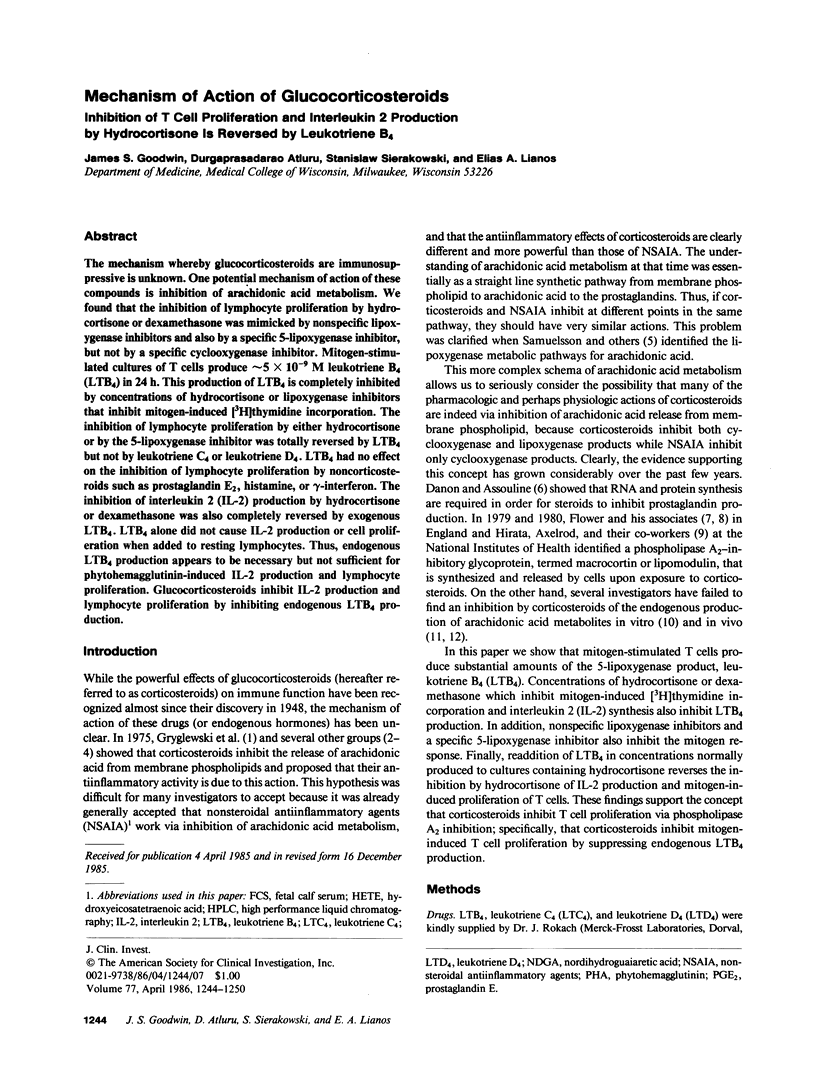

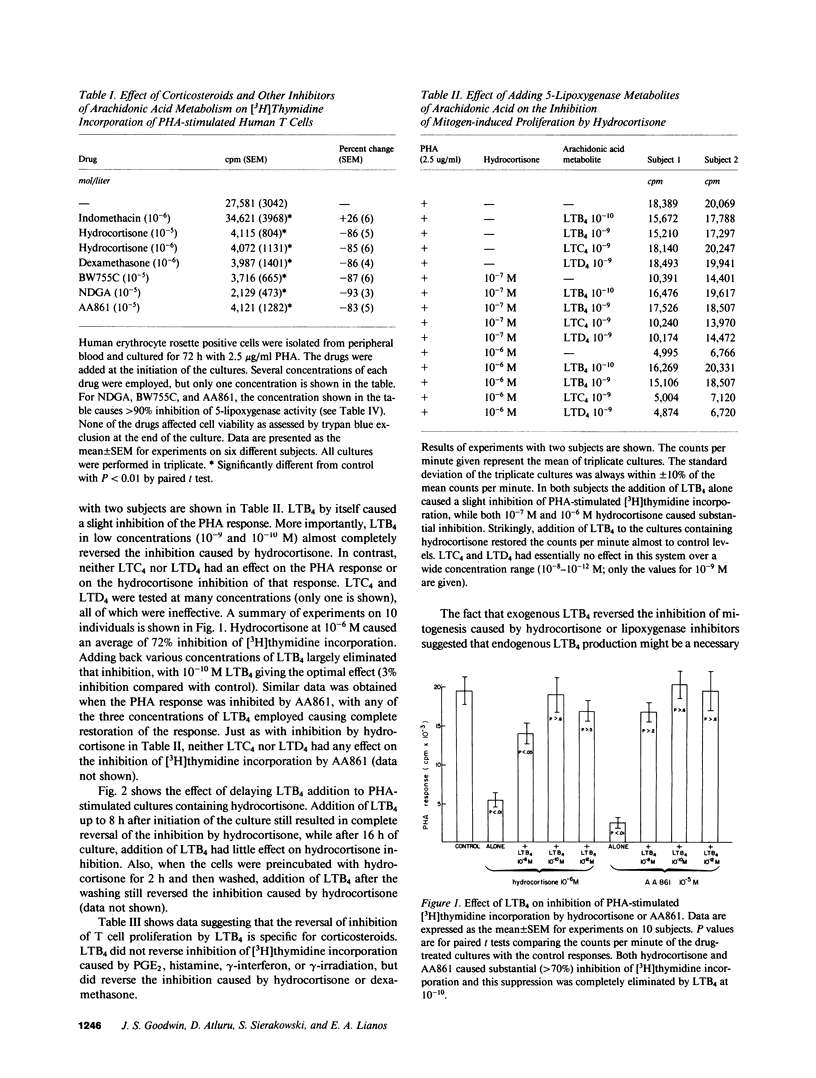
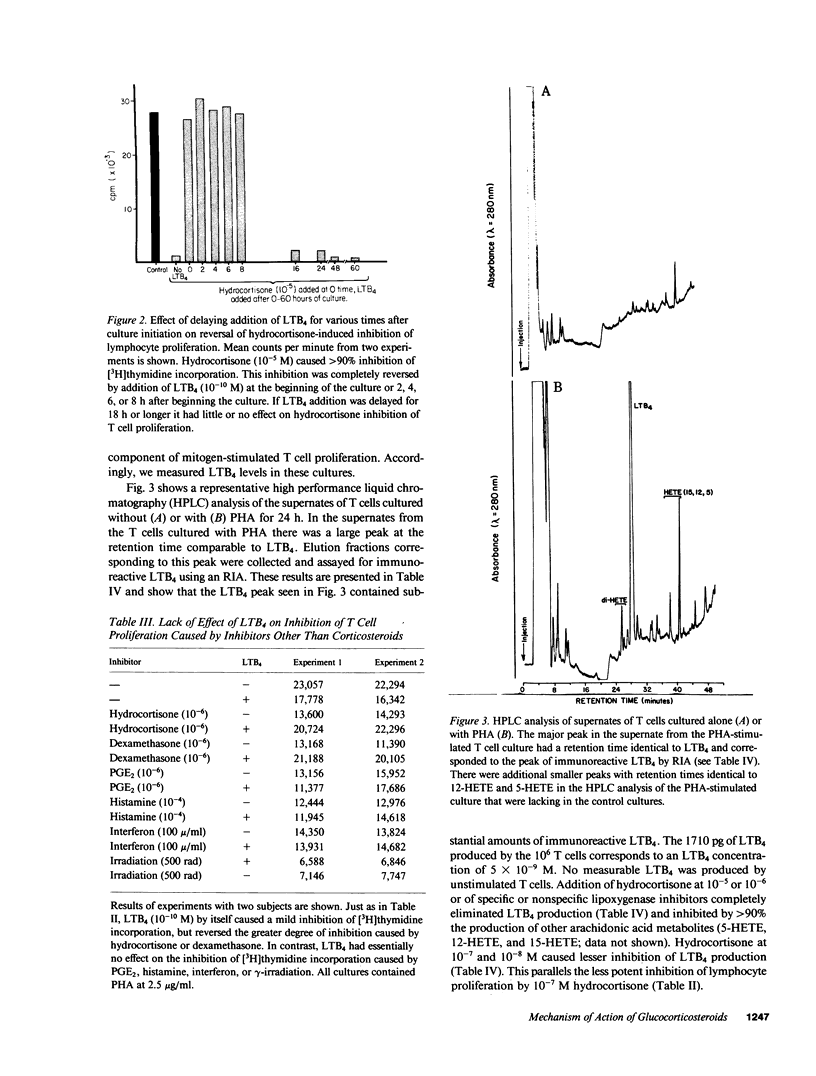
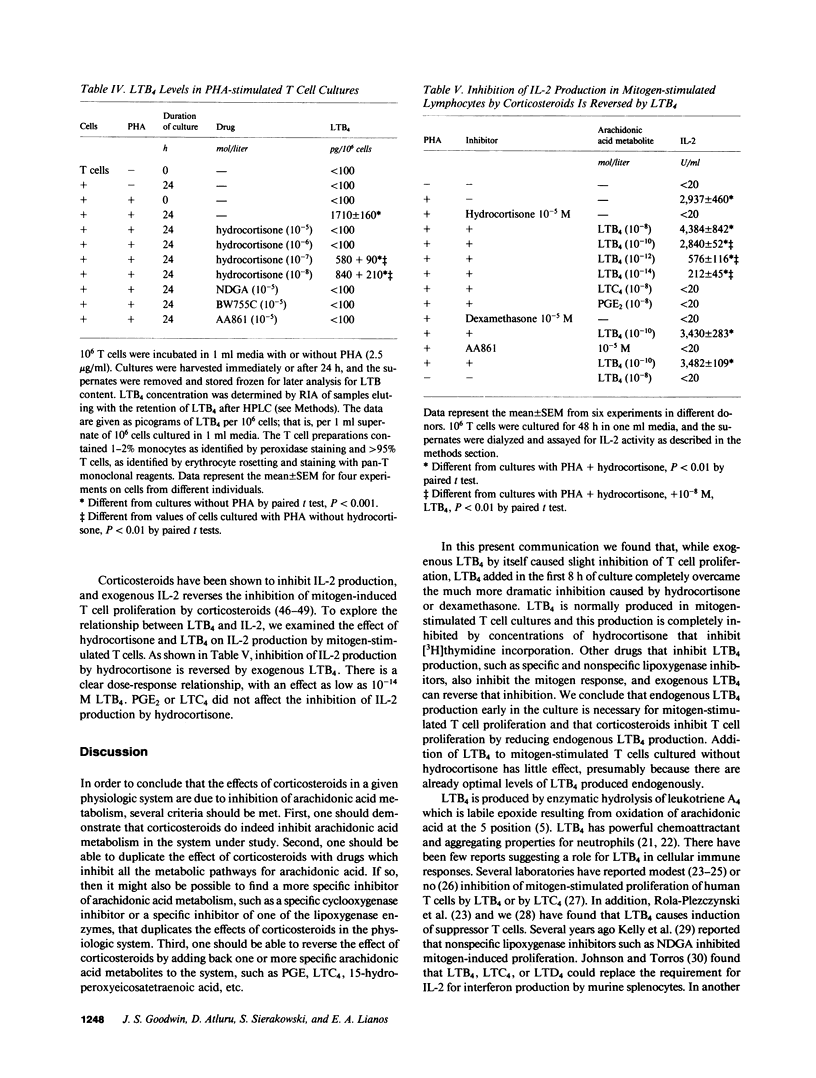
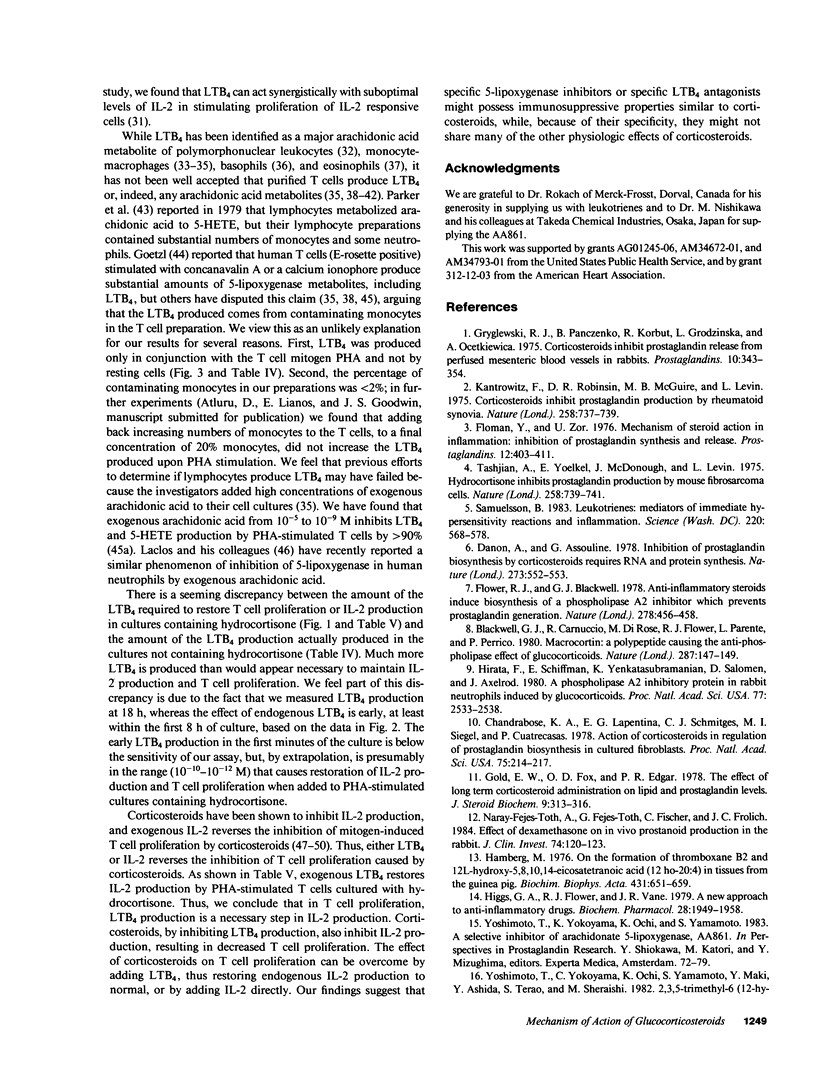
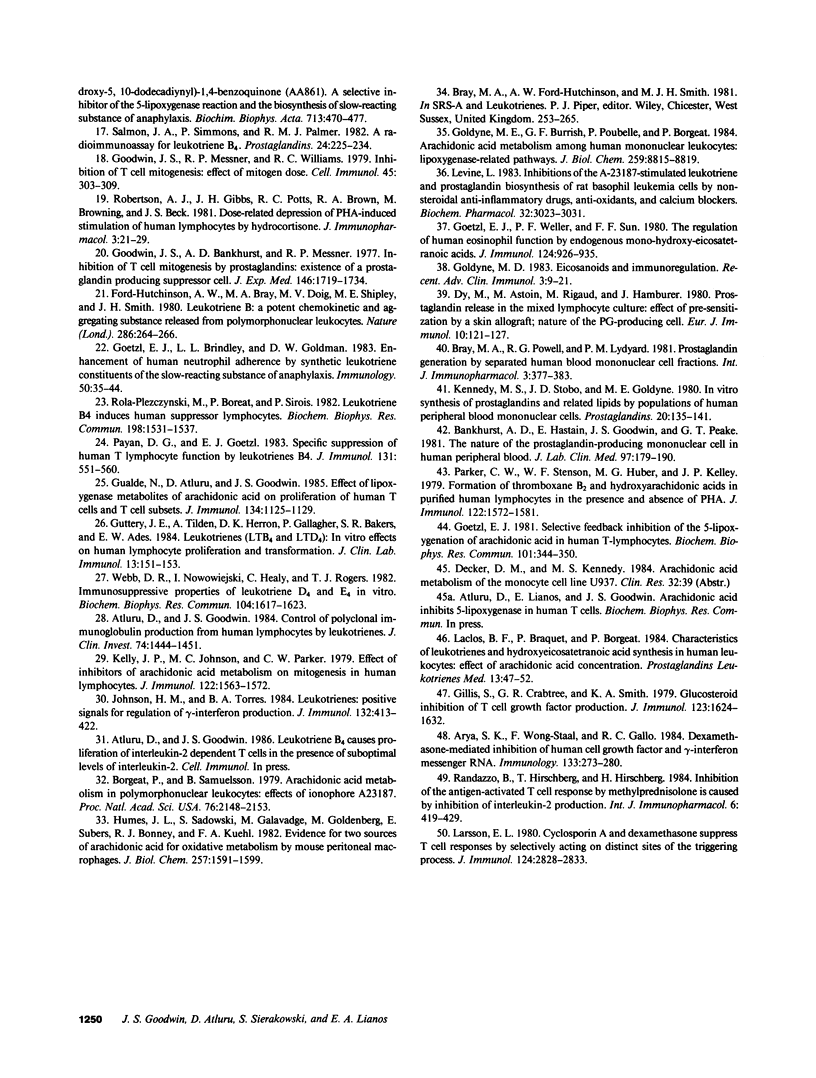
Images in this article
Selected References
These references are in PubMed. This may not be the complete list of references from this article.
- Arya S. K., Wong-Staal F., Gallo R. C. Dexamethasone-mediated inhibition of human T cell growth factor and gamma-interferon messenger RNA. J Immunol. 1984 Jul;133(1):273–276. [PubMed] [Google Scholar]
- Atluru D., Goodwin J. S. Control of polyclonal immunoglobulin production from human lymphocytes by leukotrienes; leukotriene B4 induces an OKT8(+), radiosensitive suppressor cell from resting, human OKT8(-) T cells. J Clin Invest. 1984 Oct;74(4):1444–1450. doi: 10.1172/JCI111556. [DOI] [PMC free article] [PubMed] [Google Scholar]
- Bankhurst A. D., Hastain E., Goodwin J. S., Peake G. T. The nature of the prostaglandin-producing mononuclear cell in human peripheral blood. J Lab Clin Med. 1981 Feb;97(2):179–186. [PubMed] [Google Scholar]
- Blackwell G. J., Carnuccio R., Di Rosa M., Flower R. J., Parente L., Persico P. Macrocortin: a polypeptide causing the anti-phospholipase effect of glucocorticoids. Nature. 1980 Sep 11;287(5778):147–149. doi: 10.1038/287147a0. [DOI] [PubMed] [Google Scholar]
- Borgeat P., Samuelsson B. Arachidonic acid metabolism in polymorphonuclear leukocytes: effects of ionophore A23187. Proc Natl Acad Sci U S A. 1979 May;76(5):2148–2152. doi: 10.1073/pnas.76.5.2148. [DOI] [PMC free article] [PubMed] [Google Scholar]
- Bray M. A., Powell R. G., Lydyard P. M. Prostaglandin generation by separated human blood mononuclear cell fractions. Int J Immunopharmacol. 1981;3(4):377–381. doi: 10.1016/0192-0561(81)90033-3. [DOI] [PubMed] [Google Scholar]
- Chandrabose K. A., Lapetina E. G., Schmitges C. J., Siegel M. I., Cuatrecasas P. Action of corticosteroids in regulation of prostaglandin biosynthesis in cultured fibroblasts. Proc Natl Acad Sci U S A. 1978 Jan;75(1):214–217. doi: 10.1073/pnas.75.1.214. [DOI] [PMC free article] [PubMed] [Google Scholar]
- Danon A., Assouline G. Inhibition of prostaglandin biosynthesis by corticosteroids requires RNA and protein synthesis. Nature. 1978 Jun 15;273(5663):552–554. doi: 10.1038/273552a0. [DOI] [PubMed] [Google Scholar]
- Dy M., Astoin M., Rigaud M., Hamburger J. Prostaglandin (PG) release in the mixed lymphocyte culture; effect of presensitization by a skin allograft; nature of the PG-producing cell. Eur J Immunol. 1980 Feb;10(2):121–126. doi: 10.1002/eji.1830100210. [DOI] [PubMed] [Google Scholar]
- Floman Y., Zor U. Mechanism of steroid action in inflammation: inhibition of prostaglandin synthesis and release. Prostaglandins. 1976 Sep;12(3):403–413. doi: 10.1016/0090-6980(76)90021-6. [DOI] [PubMed] [Google Scholar]
- Flower R. J., Blackwell G. J. Anti-inflammatory steroids induce biosynthesis of a phospholipase A2 inhibitor which prevents prostaglandin generation. Nature. 1979 Mar 29;278(5703):456–459. doi: 10.1038/278456a0. [DOI] [PubMed] [Google Scholar]
- Ford-Hutchinson A. W., Bray M. A., Doig M. V., Shipley M. E., Smith M. J. Leukotriene B, a potent chemokinetic and aggregating substance released from polymorphonuclear leukocytes. Nature. 1980 Jul 17;286(5770):264–265. doi: 10.1038/286264a0. [DOI] [PubMed] [Google Scholar]
- Fruteau de Laclos B., Braquet P., Borgeat P. Characteristics of leukotriene (LT) and hydroxy eicosatetraenoic acid (HETE) synthesis in human leukocytes in vitro: effect of arachidonic acid concentration. Prostaglandins Leukot Med. 1984 Jan;13(1):47–52. doi: 10.1016/0262-1746(84)90101-x. [DOI] [PubMed] [Google Scholar]
- Gillis S., Crabtree G. R., Smith K. A. Glucocorticoid-induced inhibition of T cell growth factor production. I. The effect on mitogen-induced lymphocyte proliferation. J Immunol. 1979 Oct;123(4):1624–1631. [PubMed] [Google Scholar]
- Goetzl E. J., Brindley L. L., Goldman D. W. Enhancement of human neutrophil adherence by synthetic leukotriene constituents of the slow-reacting substance of anaphylaxis. Immunology. 1983 Sep;50(1):35–41. [PMC free article] [PubMed] [Google Scholar]
- Goetzl E. J. Selective feed-back inhibition of the 5-lipoxygenation of arachidonic acid in human T-lymphocytes. Biochem Biophys Res Commun. 1981 Jul 30;101(2):344–350. doi: 10.1016/0006-291x(81)91266-3. [DOI] [PubMed] [Google Scholar]
- Goetzl E. J., Weller P. F., Sun F. F. The regulation of human eosinophil function by endogenous mono-hydroxy-eicosatetraenoic acids (HETEs). J Immunol. 1980 Feb;124(2):926–933. [PubMed] [Google Scholar]
- Gold E. W., Fox O. D., Edgar P. R. The effect of long term corticosteroid administration of lipid and prostaglandin levels. J Steroid Biochem. 1978 Apr;9(4):313–316. doi: 10.1016/0022-4731(78)90623-4. [DOI] [PubMed] [Google Scholar]
- Goldyne M. E., Burrish G. F., Poubelle P., Borgeat P. Arachidonic acid metabolism among human mononuclear leukocytes. Lipoxygenase-related pathways. J Biol Chem. 1984 Jul 25;259(14):8815–8819. [PubMed] [Google Scholar]
- Goodwin J. S., Bankhurst A. D., Messner R. P. Suppression of human T-cell mitogenesis by prostaglandin. Existence of a prostaglandin-producing suppressor cell. J Exp Med. 1977 Dec 1;146(6):1719–1734. doi: 10.1084/jem.146.6.1719. [DOI] [PMC free article] [PubMed] [Google Scholar]
- Goodwin J. S., Messner R. P., Williams R. C., Jr Inhibitors of T-cell mitogenesis: effect of mitogen dose. Cell Immunol. 1979 Jul;45(2):303–308. doi: 10.1016/0008-8749(79)90390-3. [DOI] [PubMed] [Google Scholar]
- Gryglewski R. J., Panczenko B., Korbut R., Grodzinska L., Ocetkiewicz A. Corticosteroids inhibit prostaglandin release from perfused mesenteric blood vessels of rabbit and from perfused lungs of sensitized guinea pig. Prostaglandins. 1975 Aug;10(2):343–355. doi: 10.1016/0090-6980(75)90053-2. [DOI] [PubMed] [Google Scholar]
- Gualde N., Atluru D., Goodwin J. S. Effect of lipoxygenase metabolites of arachidonic acid on proliferation of human T cells and T cell subsets. J Immunol. 1985 Feb;134(2):1125–1129. [PubMed] [Google Scholar]
- Guttery J. E., Tilden A., Herron D. K., Gallagher P., Baker S. R., Ades E. W. Leukotrienes (LTB4 and LTD4): in vitro effects on human lymphocyte proliferation and transformation. J Clin Lab Immunol. 1984 Mar;13(3):151–153. [PubMed] [Google Scholar]
- Hamberg M. On the formation of thromboxane B2 and 12l-hydroxy-5,8,10,14-eicosatetraenoic acid (12 ho-20:4) in tissues from the guinea pig. Biochim Biophys Acta. 1976 Jun 22;431(3):651–654. doi: 10.1016/0005-2760(76)90232-0. [DOI] [PubMed] [Google Scholar]
- Hirata F., Schiffmann E., Venkatasubramanian K., Salomon D., Axelrod J. A phospholipase A2 inhibitory protein in rabbit neutrophils induced by glucocorticoids. Proc Natl Acad Sci U S A. 1980 May;77(5):2533–2536. doi: 10.1073/pnas.77.5.2533. [DOI] [PMC free article] [PubMed] [Google Scholar]
- Humes J. L., Sadowski S., Galavage M., Goldenberg M., Subers E., Bonney R. J., Kuehl F. A., Jr Evidence for two sources of arachidonic acid for oxidative metabolism by mouse peritoneal macrophages. J Biol Chem. 1982 Feb 25;257(4):1591–1594. [PubMed] [Google Scholar]
- Johnson H. M., Torres B. A. Leukotrienes: positive signals for regulation of gamma-interferon production. J Immunol. 1984 Jan;132(1):413–416. [PubMed] [Google Scholar]
- Kantrowitz F., Robinson D. R., McGuire M. B., Levine L. Corticosteroids inhibit prostaglandin production by rheumatiod synovia. Nature. 1975 Dec 25;258(5537):737–739. doi: 10.1038/258737a0. [DOI] [PubMed] [Google Scholar]
- Kelly J. P., Johnson M. C., Parker C. W. Effect of inhibitors of arachidonic acid metabolism on mitogenesis in human lymphocytes: possible role of thromboxanes and products of the lipoxygenase pathway. J Immunol. 1979 Apr;122(4):1563–1571. [PubMed] [Google Scholar]
- Kennedy M. S., Stobo J. D., Goldyne M. E. In vitro synthesis of prostaglandins and related lipids by populations of human peripheral blood mononuclear cells. Prostaglandins. 1980 Jul;20(1):135–145. doi: 10.1016/0090-6980(80)90013-1. [DOI] [PubMed] [Google Scholar]
- Larsson E. L. Cyclosporin A and dexamethasone suppress T cell responses by selectively acting at distinct sites of the triggering process. J Immunol. 1980 Jun;124(6):2828–2833. [PubMed] [Google Scholar]
- Levine L. Inhibition of the A-23187-stimulated leukotriene and prostaglandin biosynthesis of rat basophil leukemia (RBL-1) cells by nonsteroidal anti-inflammatory drugs, antioxidants, and calcium channel blockers. Biochem Pharmacol. 1983 Oct 15;32(20):3023–3026. doi: 10.1016/0006-2952(83)90244-7. [DOI] [PubMed] [Google Scholar]
- Náray-Fejes-Tóth A., Fejes-Tóth G., Fischer C., Frölich J. C. Effect of dexamethasone on in vivo prostanoid production in the rabbit. J Clin Invest. 1984 Jul;74(1):120–123. doi: 10.1172/JCI111391. [DOI] [PMC free article] [PubMed] [Google Scholar]
- Parker C. W., Stenson W. F., Huber M. G., Kelly J. P. Formation of thromboxane B2 and hydroxyarachidonic acids in purified human lymphocytes in the presence and absence of PHA. J Immunol. 1979 Apr;122(4):1572–1577. [PubMed] [Google Scholar]
- Payan D. G., Goetzl E. J. Specific suppression of human T lymphocyte function by leukotriene B4. J Immunol. 1983 Aug;131(2):551–553. [PubMed] [Google Scholar]
- Randazzo B., Hirschberg T., Hirschberg H. Inhibition of the antigen activated T cell response by methylprednisolone is caused by inhibition of interleukin-2 (IL-2) production. Int J Immunopharmacol. 1984;6(5):419–423. doi: 10.1016/0192-0561(84)90079-1. [DOI] [PubMed] [Google Scholar]
- Robertson A. J., Gibbs J. H., Potts R. C., Brown R. A., Browning M. C., Beck J. S. Dose-related depression of PHA-induced stimulation of human lymphocytes by hydrocortisone. Int J Immunopharmacol. 1981;3(1):21–29. doi: 10.1016/0192-0561(81)90042-4. [DOI] [PubMed] [Google Scholar]
- Rola-Pleszczynski M., Borgeat P., Sirois P. Leukotriene B4 induces human suppressor lymphocytes. Biochem Biophys Res Commun. 1982 Oct 29;108(4):1531–1537. doi: 10.1016/s0006-291x(82)80081-8. [DOI] [PubMed] [Google Scholar]
- Salmon J. A., Simmons P. M., Palmer R. M. A radioimmunoassay for leukotriene B4. Prostaglandins. 1982 Aug;24(2):225–235. doi: 10.1016/0090-6980(82)90148-4. [DOI] [PubMed] [Google Scholar]
- Samuelsson B. Leukotrienes: mediators of immediate hypersensitivity reactions and inflammation. Science. 1983 May 6;220(4597):568–575. doi: 10.1126/science.6301011. [DOI] [PubMed] [Google Scholar]
- Tashjian A. H., Jr, Voelkel E. F., McDonough J., Levine L. Hydrocortisone inhibits prostaglandin production by mouse fibrosarcoma cells. Nature. 1975 Dec 25;258(5537):739–741. doi: 10.1038/258739a0. [DOI] [PubMed] [Google Scholar]
- Webb D. R., Nowowiejski I., Healy C., Rogers T. J. Immunosuppressive properties of leukotriene D4 and E4 in vitro. Biochem Biophys Res Commun. 1982 Feb 26;104(4):1617–1622. doi: 10.1016/0006-291x(82)91438-3. [DOI] [PubMed] [Google Scholar]
- Yoshimoto T., Yokoyama C., Ochi K., Yamamoto S., Maki Y., Ashida Y., Terao S., Shiraishi M. 2,3,5-Trimethyl-6-(12-hydroxy-5,10-dodecadiynyl)-1,4-benzoquinone (AA861), a selective inhibitor of the 5-lipoxygenase reaction and the biosynthesis of slow-reacting substance of anaphylaxis. Biochim Biophys Acta. 1982 Nov 12;713(2):470–473. [PubMed] [Google Scholar]



